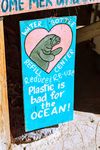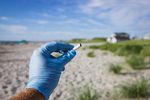WHAT A WASTE: THE TRUTH ABOUT PLASTICS POLLUTION
←
→
Page content transcription
If your browser does not render page correctly, please read the page content below
WHAT A WASTE: THE TRUTH
ABOUT PLASTICS POLLUTION
[VIDEO TRANSCRIPT]
So, you’ve probably heard that America has a problem with plastic.
You know what? Scratch that. We have multiple problems with plastic.
But the one that most directly affects you involves the kinds of
products you use every day—things like straws, water bottles, or
shopping bags.
Up until a few years ago, it didn’t seem like a very big deal. And
then, suddenly...everything changed.
So what happened? Why did we all suddenly start worrying about
something we had taken for granted for decades?
While we’ve known for a long time that there’s a problem with
plastic waste winding up in the ocean, the tipping point came with
a viral video that showed a sea turtle...
having a plastic straw removed
from its nose...with pliers.
And...it’s just as
terrible as it sounds.
WATCH VIDEO ONLINENow, when people saw that video, they wanted to
take action, and rightly so—because, when it comes
to creatures that the human brain can’t bear to
see in agony, turtles are right up there with
puppies and Betty White. You watch this video, and
you’d do anything to make the suffering of that
innocent creature stop.
Ironically, the development of consumer plastics actually played a role
in saving turtles too. Scientists estimate that over 9 million hawksbill
sea turtles were killed by humans for their shells. One of the reasons
the practice declined? The development of cellulose acetate, the
plastic that is used to create modern tortoiseshell designs.
There’s good reason to be upset. About 11
million metric tons of plastic end up in the
world’s oceans each year.1
And it’s estimated to have negative effects on over 800 different
species.2 So it didn’t seem unreasonable when people started making
the argument that if Americans want less plastic in the ocean, they
need to start banning plastic on land.
Where has this happened in the U.S.? Eight states currently ban single-use plastic bags: California,
Connecticut, Delaware, Hawaii, Maine, New York, Oregon, and Vermont. New Jersey will prohibit them beginning
in 2022. While no state has imposed an outright ban on plastic straws, states such as California, Oregon,
and Vermont prohibit their use unless specifically requested by a customer. Some cities have enacted plastic
straw bans, however, and many vendors have voluntarily stopped providing them.
But, see, this is where we’ve got to be careful. Because “doesn’t
seem unreasonable” isn’t the same thing as “is actually true.”
There’s a lot of misunderstanding about plastics, partially because
in the initial rush to make things better, some of the sources we
relied on to explain these things were a little...imprecise.
For instance, when the bans were first proposed, we were told that
Americans use 500 million plastic straws a day—which is pretty
remarkable for a country of 330 million people.
2So where did that number come from? Well, from the National Park
Service—and they obviously know what they’re talking about...
except they got it from a recycling company, which probably knows
what it’s talking about? Except the recycling company got it [deep
sigh]...OK, they got it from a nine-year-old boy...who called some
straw companies.3
So what’s the real number of straws Americans use every day? No
one really knows, but it’s definitely less than 500 million. Estimates
by a pair of market research firms place
the number somewhere between 170 million
and 390 million.
So how many straws do we use every year? Here’s the surprising
answer: it doesn’t matter. Because here’s what we got wrong:
The problem isn’t plastic waste itself—it’s how it’s disposed of.
You may have heard that the United States produces more plastic
waste than any country in the world except China, and that’s true.4
But there’s a more important statistic there. Nearly 75% of China’s
plastic waste is mismanaged, meaning it’s so poorly secured that it
may end up in the ocean. The percentage in the U.S.? Less than 1%.5
CHINA
What does it mean for waste to be “poorly
secured”? Usually it means that trash is
dumped in or near a waterway, allowing it
to eventually drift out in the open ocean.
America might be one of the world’s leaders
in generating plastic waste, but we’re
also one of the world’s leaders in not
treating the planet like our dorm room.
[Don’t get too full of yourself. Your
grandparents defeated the Nazis. You just
successfully threw away some Funyuns.]
3The real problem when it comes to plastics pollution is quite
literally half a world away. Over 80% of the plastic waste in the
ocean comes from Asia, where improperly disposed trash is often
dumped into rivers that allow it to drift out to the ocean. In
fact, nearly half of the plastic in our oceans comes from just two
countries—the Philippines and India.6
In addition to pollution that drifts into the ocean
We could ban all plastics in the from land-based sources, there is also a serious
U.S.—not just bags and straws, but problem with waste that is dumped directly from
everything from Legos to traffic marine vessels. Research suggests that this trash
comes disproportionately from China.
cones—and barely make a difference.
Now, here’s the catch. We’re not totally blameless here. If we
really wanted to make a difference, one thing we could do is to
stop exporting our trash to the countries causing the pollution.
For years, many of these countries made money by taking some of
our waste for processing—meaning that, despite our positive track-
record domestically, we were indirectly contributing to the problem
overseas. The good news, however, is that we’ve already cut those
exports by more than 2/3 in just the past five years7—but we could
still go further.
And we can help out at the
individual level too, though
the most effective method may
surprise you...
According to the government’s
NOAA (National Oceanic and
Atmospheric Administration),
the most valuable thing
we can do is clean up our
local beaches.8 Because in
a country that properly
manages its waste, the
biggest problem...is us, as
individual litterers.
For all the concern about straws and shopping bags, they’re not
the largest sources of litter in the United States. According to
a 2020 study from Keep America Beautiful, the most frequently
littered item in the country is cigarette butts.
4As for bans on plastic: not only do they not do much to solve the
problem, they’re also riddled with unintended consequences.
Research has shown that consumers who can’t get plastic grocery
bags just tend to buy more plastic trash bags.9 Substituting paper
bags for plastic ones actually results in higher carbon emissions.10
And if you ever try to drink a milkshake through a paper straw...
you’re gonna break a rib.
Keeping plastics out of the ocean is an
important goal—which is why we should
focus our efforts on the approaches that
are most likely to make a real difference.
The turtles will thank you.
And so will Betty White.
o
xo x
[END OF SCRIPT]
FOLLOW US ON SOCIAL MEDIA:
@kiteandkeymedia
SOURCES:
1 Confronting Ocean Plastic Pollution — Pew Charitable Trusts
2 Marine Debris: Understanding, Preventing, and Mitigating the Significant
Adverse Impacts on Marine and Coastal Biodiversity — United Nations
3 ”How a 9-Year-Old Boy’s Statistic Shaped a Debate on Straws” — New York
Times
4 Plastic Pollution (Hannah Ritche and Max Roser) — Our World in Data
5 Ibid.
6 Where Does the Plastic in Our Oceans Come From? (Hannah Ritche) — Our
World in Data
7 Exports of Scrap Plastic From the United States From 2015 to 2020 —
Statista
8 Garbage Patches Explained — National Oceanic and Atmospheric
Administration
9 Bag Leakage: The Effect of Disposable Carryout Bag Regulations on
Unregulated Bags (Rebecca L.C. Taylor) — SSRN
10 Bag Leakage: The Effect of Disposable Carryout Bag Regulations on
Unregulated Bags (Rebecca L.C. Taylor) — Journal of Environmental Economics and
Management
IMAGE CREDITS: commandoXphoto, David Livingston, mikroman6, Jamroen Jaiman,
EyeEm, Spiderstock, Jose Luis Pelaez, Jacobs Stock Photography Ltd, Brian To
(Getty) // Paramount Pictures // The Leatherback Trust (YouTube) // CBS New York
// CBSDFW // Merritt Thomas, Pickawood, Nuno Alberto, Brian Yurasits (Unsplash)
// Microsoft Corporation (Earthstar Geographics) // Tobin (Flickr)
5You can also read



























































